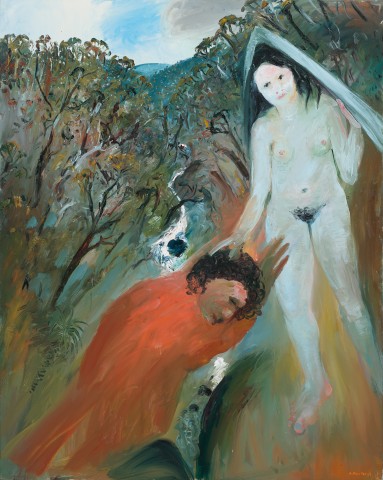THE PRINCESS OF SHAMAKHAN (FROM A PUSHKIN FAIRYTALE) VERSION II, 1983
ARTHUR BOYD
oil on canvas
152.5 x 122.0 cm
signed lower right: Arthur Boyd
Fischer Fine Art Limited, London (label attached verso)
Bonython-Meadmore Gallery, Adelaide
Private collection, Adelaide, acquired from the above in 1984
Arthur Boyd: Recent Work, Fischer Fine Art Limited, London, 26 October – 25 November 1983, cat. 16 (illus. in exhibition catalogue, p. 14)
Arthur Boyd, Bonython-Meadmore Gallery, Adelaide, 30 November – 22 December 1984, cat. 8
Forwood, G., 'Ballets Russes: from St Petersburg to St Kilda', Art and Australia, vol. 26, no. 2, Summer 1988, p. 273 (illus.)
As a child, Arthur Boyd was mesmerised by the Old Testament stories his grandmother read to him from the lavishly illustrated family bible. These and related allegorical tales, full of human frailty and struggle, appealed to Boyd’s humanist nature so it is not surprising that a number of his celebrated works were based on subjects including the expulsion of Adam and Eve, the return of the Prodigal Son, the dissembling of Nebuchadnezzar, or Prometheus stealing fire from the gods. Boyd was the most talented of his artistic family and demonstrated formidable skills in painting, ceramics, drawing and printmaking, the latter of which were utilised in a number of collaborative books with the poet Peter Porter. A similar project was a translation of fairy tales by the Russian author Alexander Sergeyevich Pushkin (1799 – 1837), illustrated by Boyd and published in 1978,1 which included an earlier lithographic rendering of The Princess of Shamakhan (from a Pushkin Fairytale) Version II, 1983.
The Princess appears in Pushkin’s The Tale of the Golden Cockerel (1834) which tells of a seductive but malevolent siren who lures a hapless Tsar in search of the sons he had sent off to war: ‘Day and night they moved on; it was becoming unbearable. They found no sign of killing… Suddenly, among the highest peaks, they saw a silken tent.’ Here, the Tsar found his fallen army and the bodies of his sons ‘dead, without their armour, their swords driven through each other.’ The tent opened and an apparition appears, ‘a princess of Shamakhan, shimmering with beauty like the dawn’ who led the Tsar, now washed of his sadness, into her domain ‘in utter entrancement, spellbound.’2 On returning to his kingdom, the Princess’ dark intentions are revealed and the Tsar dies from his delusion. It is a tale of the folly of human vanity that appealed to Boyd and he painted a larger version The Princess of Shoalhaven, 1978, with the eponymous river winding sinuously to the left.
Boyd revisited the theme in The Princess of Shamakhan, Version II, a far more personalised variant using the concept of a Biblical grand narrative but one located within an unmistakably Australian setting. As before, the Princess is shown in all her alluring nudity as she steps from her tent, the hapless Tsar fallen at her feet. Yet whilst The Princess of Shoalhaven is almost monochromatic, this second version is enriched with reds and ochres which amplify the sensuality of the scene. This atmosphere is further charged by the background of a tumbling river nestled in a cleft surrounded by spiky forests reminiscent of the artist’s celebrated nudes and ‘brides’ from the early 1960s. Boyd did not shy away from sexuality in his paintings and indeed the background of The Princess of Shamakhan, Version II is based on the clefts of the Shoalhaven River which to Boyd, had ‘a meaning to me apart from their geological grandeur. At times they seem quite erotic and explicitly anatomically sexual.’3 When originally exhibited in 1983, the painting was shown alongside other works by Boyd inspired by Gustave Courbet, and indeed, allusions may also be found here to Courbet’s The Source, 1862 (Metropolitan Museum of Art, New York) showing a naked woman in front of a small waterfall emerging from the rocks.4
1. Dalley, J. (trans.), Pushkin’s Fairy Tales, lithographs by Arthur Boyd, Barrie & Jenkins, London, 1978, n.p. Shamakhan is likely based on Shamakhi, home to the biggest mosque in Azerbaijan.
2. All quotes taken from Dalley, ibid.
3. Arthur Boyd: Recent Work, Fischer Fine Art Limited, London, 1983, p. 15
4. See Faunce, S., ‘Courbet: feminist in spite of himself’, in Pearce, B. (ed.), Body, Art Gallery of New South Wales, Sydney, 1997, pp. 95 – 108
ANDREW GAYNOR


